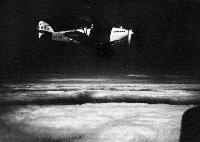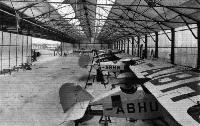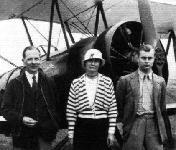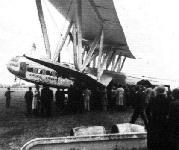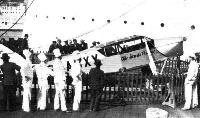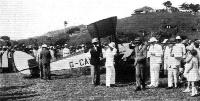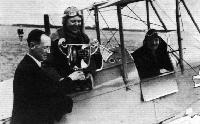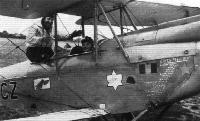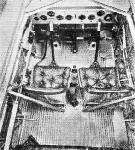Фотографии
-
Регистрационный номер: K2438 NOT A NIGHT RAIDER: The photograph shows a "Hart" of No. 33 Squadron flying above the clouds.
Самолёты на фотографии: Hawker Hart - Великобритания - 1928
-
Регистрационный номер: SP-AHN THE END OF A PERFECT FLIGHT: Zwirko crossing the finishing line on Templehof aerodrome at the end of the speed test.
Самолёты на фотографии: RWD RWD-6 / RWD-9 / RWD-20 - Польша - 1932
-
TROUBLE-FREE FOR 5,000 MILES: The Armstrong-Siddeley "Genet Major" engine fitted in Zwirko's monoplane helped greatly in producing an Anglo-Polish victory.
Самолёты на фотографии: RWD RWD-6 / RWD-9 / RWD-20 - Польша - 1932
-
Регистрационный номер: G-ABHU, G-ABHW AN AMPLE INTERIOR: Air Service Training at Hamble like plenty of room for their machines, and they get it in this B. &. P. hangar, which is 300 ft. long and 70 ft. wide.
Самолёты на фотографии: Armstrong Whitworth Atlas / Ajax - Великобритания - 1925Armstrong Whitworth Siskin - Великобритания - 1921
-
Регистрационный номер: G-ABEG The Westland "Wessex" (three 7-cylinder Genet Majors) which carried some of the Mayor's party from Heston to Romford.
Самолёты на фотографии: Westland Wessex / Westland IV - Великобритания - 1929
-
EQUAL TO 1,100 H.P.: The Bristol "Pegasus" engine would develop at ground level, could it be run at full supercharge, this impressive power. Note the Townend ring cowling.
Самолёты на фотографии: Vickers Vespa / Type 113 - Великобритания - 1925
-
Регистрационный номер: G-ABIL "SPAN SQUARE OVER W": The Vickers "Vespa" (Bristol "Pegasus") is characterised by large span and, consequently, low span loading.
Самолёты на фотографии: Vickers Vespa / Type 113 - Великобритания - 1925
-
Maj. le Baron de Woelmont, Chief of the Staff to Gen. Gillieaux, in his Fairey "Firefly" (Rolls-Royce "Kestrel").
Самолёты на фотографии: Fairey Firefly - Великобритания - 1925
-
THE BROAD ARROW: Six "Fireflies" of a Belgian squadron from Nivelles.
Самолёты на фотографии: Fairey Firefly - Великобритания - 1925
-
AN ESCADRILLE FROM NIVELLES: Good formation flying by a Belgian squadron in "Fireflies."
Самолёты на фотографии: Fairey Firefly - Великобритания - 1925
-
"FIREFLY" PILOTS AT NIVELLES: Standing (left to right), Sergent Pieret, Ier Sergent Doppagne, Adjudant Sauveniere, Capitaine Duthoit, Major Baron de Woelmont, Capitaine Norbert Leboutte, Caporal Richard, Ier Sergent Tahon, Ier Sergent Vincent. Sitting (left to right), Adjudant De Coninck, Ier Sergent Dubois, Sergent Genin, Sergent Vandelanotte, Sergent Desmyttere.
Самолёты на фотографии: Fairey Firefly - Великобритания - 1925
-
MEN, WOMEN, AND THE MACHINE: The picture on the left shows "Fireflies" receiving finishing touches in the erecting shop at the Fairey works at Gosselies. On the right is a group of the staff at Gosselies.
Самолёты на фотографии: Fairey Firefly - Великобритания - 1925
-
"FIREFLIES" AT NIVELLES: Other squadrons equipped with the same type are stationed at Schaffen.
Самолёты на фотографии: Fairey Firefly - Великобритания - 1925
-
An amusing contrast was provided by Mr. Hudson's 1902 Oldsmobile - still very mobile - and the Hawker "Fury" (" Kestrel ") - still more mobile!
Самолёты на фотографии: Hawker Fury - Великобритания - 1931
-
PILOTS OF THE 5th GROUP, 1st REGIMENT D'AERONAUTIQUE, AT EVERE: Front Row (left to right), Adjudant De Groote, Capitaine Breulhez, Capitaine G. Verhaegen, Capitaine Vander Linden, Lieutenant Colonel Iserentant (Cdt. le Regiment), Major Hansenne (Commandant le Ve. Groupe), Adjudant Hoton, Ier Sergent Mouzon, Ier Sergent Baudoux. Back Row (left to right), Adjudant Crooy, Sous-Lieutenant Lenoir, Adjudant Forest, Adjudant Beerens, Adjudant Rombauts, Sergent de Vinck de Winnezeele, Ier Sergent Persenaire, Ier Sergent Dieu, Caporal Closset.
Самолёты на фотографии: Fairey Fox - Великобритания - 1925
-
FAIREY "FOXES" AT EVERE AERODROME: In the Belgian Army the "Fox" is used as a reconnaissance aeroplane.
Самолёты на фотографии: Fairey Fox - Великобритания - 1925
-
SQUADRON LINE ABREAST: No. 603 B.S. has to contend with weather. Firth of Forth is covered with haar or sea mist.
Самолёты на фотографии: Westland Wapiti - Великобритания - 1927
-
FLIGHTS IN LINE ABREAST: No. 603 B.S. indulges in many attractive formations. The dressing of the nine Westland "Wapitis" is particularly good.
Самолёты на фотографии: Westland Wapiti - Великобритания - 1927
-
SQUADRON "V": The nine "Wapitis" of No. 603 B.S. over one of the coast towns of the Firth of Forth.
Самолёты на фотографии: Westland Wapiti - Великобритания - 1927
-
Five "Wapitis" of his squadron over the Clyde.
Самолёты на фотографии: Westland Wapiti - Великобритания - 1927
-
MIST ON THE FIRTH OF CLYDE: The City of Glasgow Squadron is used to flying in murky weather.
Самолёты на фотографии: Westland Wapiti - Великобритания - 1927
-
THE HUCKS STARTER: About to start a "Jupiter" in one of the squadron's "Wapitis."
Самолёты на фотографии: Westland Wapiti - Великобритания - 1927
-
SOUTH AFRICAN AIR FORCE'S PUNITIVE EXPEDITION: The picture shows the arrival at Windhoek, the capital of the Mandated Territory of South West Africa, of "Wapiti" aeroplanes sent by the Union Government to deal with disturbances in the native territory of Ovamboland. The expedition was led by Sir Pierre van Ryneveld, K.B.E., D.S.O., who will be remembered as the first man to fly across Africa, and who is now Director of Aviation in the Union. The rebellious chief was speedily quelled, though the bombs only caused casualties to his cattle.
Самолёты на фотографии: Westland Wapiti - Великобритания - 1927
-
ECHELON ON THE RIGHT: Westland "Wapitis" (Jupiter) of the City of Glasgow B.S. in a difficult formation.
Самолёты на фотографии: Westland Wapiti - Великобритания - 1927
-
Herr Wegenast, President of the Dusseldorf Aero Club, talking to Mr. Nigel Norman after landing at Heston. His pilot is Herr Niehues.
Самолёты на фотографии: Klemm L.25 - L.28 Swallow - Германия - 1927
-
SECOND AND THIRD: Morzik (left) and Poss gained the same number of points, the former flying a Heinkel (Argus) and the latter a "Klemm" Kl.32 (Argus). Morzik has twice won the International Touring Competition.
Самолёты на фотографии: Klemm Kl.32 / Kl.36 - Германия - 1932
-
FIFTH: The De Havilland "Gipsy III" engine fitted in the "Klemm" flown by the Swiss pilot, Fretz.
Самолёты на фотографии: Klemm Kl.32 / Kl.36 - Германия - 1932
-
SECOND AND THIRD PLACE: The Argus engine was fitted in Morzik's Heinkel and Poss's "Klemm." It is here seen in the latter.
Самолёты на фотографии: Klemm Kl.32 / Kl.36 - Германия - 1932
-
Mr. and Mrs. Gardner and their son with his Avro "Cadet." Mr. Gardner is taking an extensive course at A.S.T., Hamble, where his parents also underwent a course of instruction recently.
Самолёты на фотографии: Avro Cadet / Type 631/643 - Великобритания - 1932
-
Регистрационный номер: G-AAXC [2] On the Thursday afternoon even the large seating accommodation of the H.P.42 "Heracles" was unable to cope with the demand for tea flights over London by our enthusiastic visitors.
Самолёты на фотографии: Handley Page H.P.42 / H.P.45 - Великобритания - 1930
-
Регистрационный номер: G-AAXC [2] AT CROYDON: The Heracles (with the Spartan "Cruiser") just before the start for Denmark.
Самолёты на фотографии: Handley Page H.P.42 / H.P.45 - Великобритания - 1930Spartan Cruiser - Великобритания - 1932
-
OPENING A CHOCOLATE AIR DELIVERY SERVICE: Above, Lord Apsley starting the "Gipsy" engine by swinging the propeller. Below, girls loading 4 cwt. of chocolates into the "Puss Moth."
Самолёты на фотографии: De Havilland Puss Moth / D.H.80 - Великобритания - 1929
-
Регистрационный номер: G-ABXY CULINARY INTEREST: Chefs from the C.P.R. liner "Empress of Britain" interested in J. A. Mollison's "Puss Moth" "Heart's Content" at Southampton.
Самолёты на фотографии: De Havilland Puss Moth / D.H.80 - Великобритания - 1929
-
Регистрационный номер: G-EBQL Mr. Alan Goodfellow (left) and Mr. M. L. Bramson, for Lancashire and Hanworth Clubs, respectively, clearing the tape with commendably little to spare when competing for the Hart Trophy.
Самолёты на фотографии: Avro Avian / Type 594/616 - Великобритания - 1926
-
Регистрационный номер: NR2100 FARTHER BACK THAN EVER: If the pilot's cockpit of the Granville Brothers' Gee Bee Super Sportster is moved any farther back in the next model the pilot will have to hang on to the trailing edge of the rudder and become a streamer. The machine, fitted with a supercharged Wasp engine, is credited with a speed of more than 300 m.p.h., piloted by Maj. J. Doolittle. The view from the cockpit is probably better than one would expect.
Самолёты на фотографии: Gee Bee Model Z/R Super Sportster - США - 1931
-
Ready for the start of Folkestone Aero Trophy Race. The nearest machine is Mr. MacGilchrist's "Swift" (Gipsy III), on which Mr. Styran won the race.
Самолёты на фотографии: Comper Swift / CLA.7 - Великобритания - 1930
-
Регистрационный номер: G-AAZF Mr. A. J. Styran (left) looks cheerful after his victory as does Flt. Lt. N. Comper, who, besides coming in second on a "Swift" (Pobjoy), is designer also of both machines.
Самолёты на фотографии: Comper Swift / CLA.7 - Великобритания - 1930
-
The winner of the Cup for the second arrival was M. Seligman, who with Mme. Seligman flew over from Paris in this Farman 198 (Renault 215).
Самолёты на фотографии: Farman F.190 / F.390 - Франция - 1928
-
MODERNITY: A Gloster "Gnatsnapper," fitted with Rolls-Royce "Kestrel" engine, shows how amazingly "clean" an aeroplane can be made when evaporative cooling is employed.
Самолёты на фотографии: Gloster Gnatsnapper - Великобритания - 1928
-
Регистрационный номер: D-2302 [2] THE HEINKEL He.64: This three-quarter rear view was taken at Heston shortly after the arrival of the Heinkels from Germany during the "Week-End Aerien."
Самолёты на фотографии: Heinkel He-64/He-71 - Германия - 1932
-
Регистрационный номер: D-2302 [2] "EINE HEI(N)KLE SACHE": Capt. Cordes, Handley Page's test pilot, giving a take-off demonstration at Radlett. Note lift flaps down and all slots open.
Самолёты на фотографии: Heinkel He-64/He-71 - Германия - 1932
-
Fraulein Elly Beinhorn (left) arriving with Fraulein S. Mirow in one of the new Heinkel's.
Самолёты на фотографии: Heinkel He-64/He-71 - Германия - 1932
-
GOOD BYE TO RADLETT: The three Heinkels leave in formation after their demonstrations. Note that on the leading machine the port lift slot is open and its associated flap down, while the starboard slot is closed and its flap up.
Самолёты на фотографии: Heinkel He-64/He-71 - Германия - 1932
-
Heinkel-Sport He.64
Самолёты на фотографии: Heinkel He-64/He-71 - Германия - 1932
-
Регистрационный номер: G-AAWZ The Cirrus-Hermes Engineering Co. whose latest engine the "Hermes IV" was described in FLIGHT for July 8, use a Spartan "Arrow" for their test work. Mr. J. V. Holman, their Sales Manager, is here seen beside the "Arrow."
Самолёты на фотографии: Spartan Arrow - Великобритания - 1930
-
Регистрационный номер: OO-ALY A Belgian pilot, M. Du Pont, in a "Boulte Sport" ("Gipsy I"), was actually the first foreign visitor to arrive, but he was too early to gain the Cup for the arrival competition. He is seen on the right with his passenger, M, Abeele (r).
Самолёты на фотографии: Bulte RB.30 / Bulte-Guldentops Sport - Бельгия - 1931
-
Регистрационный номер: G-ABYS SEA, LAND OR AIR: The Sikorsky (2 Wasps) of Mr. Francis Francis. The cabin is beautifully fitted, and this machine makes what is probably the most luxurious privately-owned aircraft in the country. It is in a similar Sikorsky that the Hutchinson family are flying to England, via Greenland, from New York.
Самолёты на фотографии: Sikorsky S-36 / S-38 - США - 1927
-
THE FAMILY TOUR: The Hutchinson family and crew, who attempted a flight from New York to Edinburgh in a Sikorsky amphibian, but came to grief in Greenland. Capt. George R. Hutchinson is shown seated with his wife and two daughters, Kathryn and Janet Lee. The others of the party are Peter Redpath, navigator, Joseph Ruff, mechanic, Gerald Altfilisch, radio operator, and Norman Alley, cameraman.
Самолёты на фотографии: Sikorsky S-36 / S-38 - США - 1927
-
Refuelling Capt. N. Stack's Spartan Mailplane from the Shell and "B.P." lorry at Heston prior to his flight to India and back.
Самолёты на фотографии: Spartan Cruiser - Великобритания - 1932
-
1,000 lb. being loaded into the Spartan "Cruiser" for a full-load demonstration.
Самолёты на фотографии: Spartan Cruiser - Великобритания - 1932
-
AT CROYDON: The Prince is seen de-planing from the Spartan "Cruiser" - in which he flew from Sunningdale
Самолёты на фотографии: Spartan Cruiser - Великобритания - 1932
-
The Lord Mayor of London going on board the Spartan "Cruiser" (three "Gipsy III's" at Heston. Col. Strange flew the party, which included Col. Shelmerdine, the Director of Civil Aviation, to Maylands Aerodrome, Romford.
Самолёты на фотографии: Spartan Cruiser - Великобритания - 1932
-
Регистрационный номер: G-ABTR [2] Three-seater "Spartan" ("Hermes IIB") of Lt. Col. L. Strange. A trinity which won the Isle of Thanet Cup.
Самолёты на фотографии: Simmonds Spartan - Великобритания - 1928
-
Регистрационный номер: G-ABTR [2], G-ABYN The Spartan Line-up.
Самолёты на фотографии: Simmonds Spartan - Великобритания - 1928
-
Ample room for two persons is provided in the rear cockpit of this, the latest version, of the Spartan 3-seater.
Самолёты на фотографии: Simmonds Spartan - Великобритания - 1928
-
A FAIR ITALIAN VISITOR: Miss Gaby Angelini, an Italian pilot, who is making a solo flight to the principal towns of Europe in her Breda 15, at Heston, where she arrived last week. She has already visited Prague, Berlin, Stockholm, Copenhagen and Amsterdam, and next she will fly to Paris, Lyons, Cannes, Geneva and home to Milan.
Самолёты на фотографии: Breda Ba.15 - Италия - 1928
-
A WEST INDIAN FLIGHT: Mr. Cipriani's "Hermes"-engined "Moth" at St. Vincent, after a flight from Trinidad.
Самолёты на фотографии: De Havilland Gipsy Moth / Moth X - Великобритания - 1928
-
Mr. Skorzewski in a "Moth" ("Gipsy I") was the actual winner of the arrival competition, and he is here seen receiving the Cup from Col. Shelmerdine, the Director of Civil Aviation.
Самолёты на фотографии: De Havilland Gipsy Moth / Moth X - Великобритания - 1928
-
Регистрационный номер: G-AACY THE ELECTRICALLY-FIRED TYPE: The battery of flares may be seen strapped to the side of the fuselage (as a temporary measure). This picture of a "Gipsy Moth" belonging to Airwork, Ltd., was taken at Hanworth, by the light of a Chance Brothers floodlight.
Самолёты на фотографии: De Havilland Gipsy Moth / Moth X - Великобритания - 1928
-
Another arrival at Heston was M. Frederic Jamar, who, as can be seen from the illustration, hails from the Belgian Congo.
Самолёты на фотографии: De Havilland Gipsy Moth / Moth X - Великобритания - 1928
-
Регистрационный номер: OO-AMT This St. Hubert of M. Pierre Osterrieth was one of the best finished foreign machines to come over.
Самолёты на фотографии: Orta Saint-Hubert G.1 - Бельгия - 1928
-
Three-quarter front and rear views of the Scud II outside Mr. E. D. Abbott's works at Farnham.
Самолёты на фотографии: Abbott-Baynes Scud - Великобритания - 1931
-
A front view of the Scud II showing the clean lines.
Самолёты на фотографии: Abbott-Baynes Scud - Великобритания - 1931
-
SCUD II
Самолёты на фотографии: Abbott-Baynes Scud - Великобритания - 1931
-
Регистрационный номер: CF-ARF [5] Самолёты на фотографии: Boeing Totem - США - 1931
-
Регистрационный номер: CF-ARF [5] THREE-QUARTER REAR VIEW OF BOEING "TOTEM": The "Wasp Jr." engine is installed as a pusher.
Самолёты на фотографии: Boeing Totem - США - 1931
-
Регистрационный номер: CF-ARF [5] THE BOEING "TOTEM": An interesting view of this Canadian-built machine in flight.
Самолёты на фотографии: Boeing Totem - США - 1931
-
Регистрационный номер: CF-ARF [5] A Retractable Water Rudder is a feature of the "Totem." When retracted the Water Rudder disappears into the Air Rudder.
Самолёты на фотографии: Boeing Totem - США - 1931
-
Регистрационный номер: CF-ARF [5] Roomy accommodation is provided for four, including the pilot, Note the dual controls.
Самолёты на фотографии: Boeing Totem - США - 1931
-
The Boeing "Totem" 300 h.p. Wasp Jr. Engine
Самолёты на фотографии: Boeing Totem - США - 1931
Статьи
- Flight
